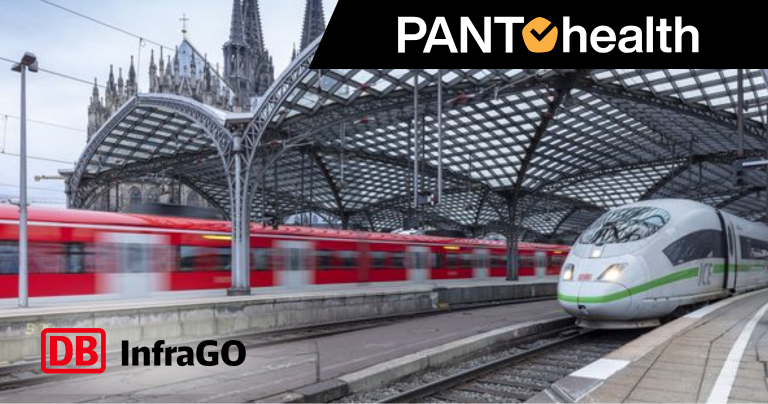Improving Railway Maintenance with Advanced Data Analytics
Pain Points Addressed
DB InfraGO (formerly DB Netze), a subsidiary of Deutsche Bahn, is responsible for railway infrastructure optimization in Germany’s vast railway infrastructure, including thousands of kilometers of overhead catenary systems. Ensuring the reliability and safety of these systems is a critical task, requiring railway condition monitoring and precise maintenance planning.
DB InfraGO conducts periodic inspections to maintain high operational standards, leveraging extensive measurement data from dedicated diagnostic trains such as the ICE-S. These inspections help detect potential issues using predictive railway maintenance and structured evaluation processes.
However, given the increasing volume of collected data—exceeding one gigabyte per kilometer—there was an opportunity to further optimize maintenance strategies by integrating advanced data analysis methods.
DB InfraGO explored new approaches to utilize this data for predictive maintenance, recognizing the potential to enhance efficiency and leverage historical insights. As part of a feasibility study, PANTOhealth evaluated how its AI-driven analytics and visualization tools could support DB’s structured maintenance framework by providing deeper insights into periodic inspection data.
Previous Client Approach
DB InfraGO’s established maintenance strategy follows a structured approach based on threshold-based assessments of overhead line equipment (OLE) monitoring. While this method has ensured reliability and adherence to operational standards, it primarily focuses on identifying immediate concerns rather than long-term trend analysis.
Maintenance crews received reports based on threshold exceedances, ensuring safety and operational guidelines compliance. However, a more detailed analysis of evolving trends were needed. For instance, examining recurring patterns in catenary wear, environmental impacts, and gradual degradation required closer examination. These analysis could refine intervention planning and optimize resource allocation.
By incorporating historical data trends and advanced defect correlation analysis, PANTOhealth’s solution aimed to complement DB InfraGO’s maintenance efforts, offering a more dynamic and data-driven railway analytics approach to infrastructure monitoring.
Our Solution
PANTOhealth proposed a comprehensive solution to optimize DB Netze’s maintenance practices by focusing on the untapped potential of their collected data. The project began with analyzing raw data from DB Netze’s measurement trains over the past ten years, covering a 100-kilometer stretch from Berlin to Hamburg.
The data included parameters such as contact wire height, lateral position (zigzag), wire thickness, dynamic forces, acceleration between pantograph and catenary, lateral distance between polar wires, arcing events, and video footage.
The solution involved several key steps. We started with data extraction and processing, handling data from multiple formats, including Excel sheets and PDFs. This initial phase took about five months due to the need to unlock and format the data.
Next, we visualized the processed data on our platform, making it accessible and comprehensible. This allowed DB Netze to see trends over time and understand the progression of issues at specific points along the track.
Advanced data analysis was then conducted to identify correlations between different types of defects and their progression over time. For instance, we discovered that certain defects were more likely to appear during specific seasons, helping prioritize maintenance efforts more effectively.
Our interactive platform enabled users to interact with the data by placing tickets, making annotations, and assigning tasks directly within the system, facilitating a more integrated and efficient approach to maintenance management.
We provided API connections to ensure seamless integration with DB Netze’s existing systems. This allows our platform to connect with their computerized maintenance management systems (CMMS) and streamline the workflow.
Moreover, DB Netze was impressed by our panel’s information and valuable data. For instance, some defects do not occur at all during winter. This insight comes from the data collected once every six months, including one measurement in winter.
Since there are no issues related to natural positioning or zigzagging in winter, the maintenance crew should not be overly concerned about the zigzag defects during this season. However, they should pay more attention and prepare for these issues during the summer.
Results and Impact
The implementation of PANTOhealth’s solution positively impacted DB Netze’s maintenance operations. The head of the catenary section in Frankfurt, the primary end user, provided very positive feedback, highlighting several key benefits.
Transforming raw data into actionable insights enhances data utilization. This enabled DB Netze to move from a reactive to a proactive maintenance strategy. The visualization and analysis tools helped maintenance crews focus on critical issues, optimize resource allocation, and reduce unnecessary inspections.
Our solution helped DB Netze to track defect progression over time and identify patterns, such as the seasonal occurrence of certain defects, which informed more effective maintenance planning. The interactive features and API integration facilitated a more cohesive and efficient workflow. These actions reduced the time and effort required for data management and task coordination.
PANTOhealth’s solution improved DB Netze’s ability to maintain its overhead catenary systems by leveraging advanced data analysis, visualization, and integration capabilities. This led to more efficient and effective maintenance operations. Plus, notable improvements were seen in using historical data to advise maintenance strategies and resource allocation.
Follow PANTOhealth on LinkedIn for more updates and news about our projects.
